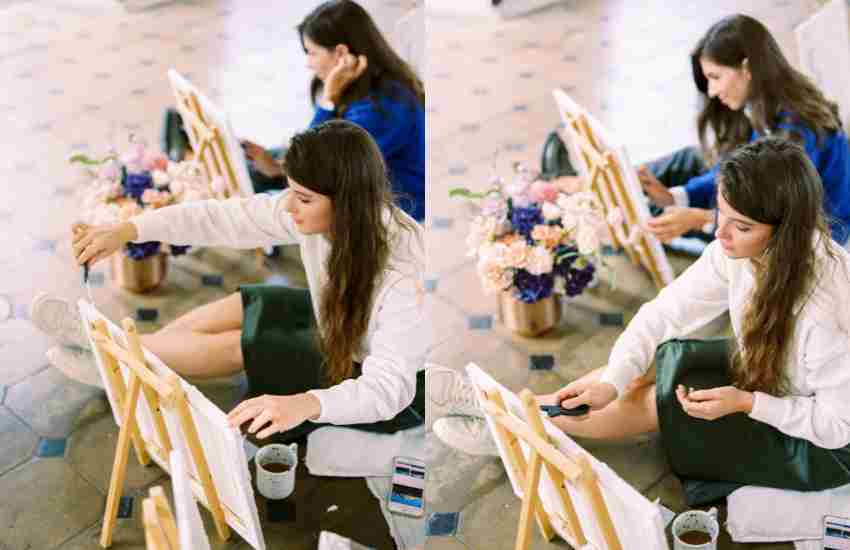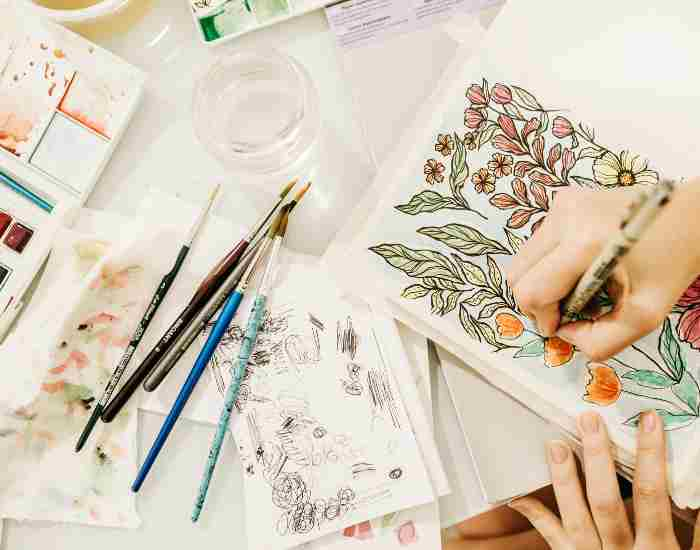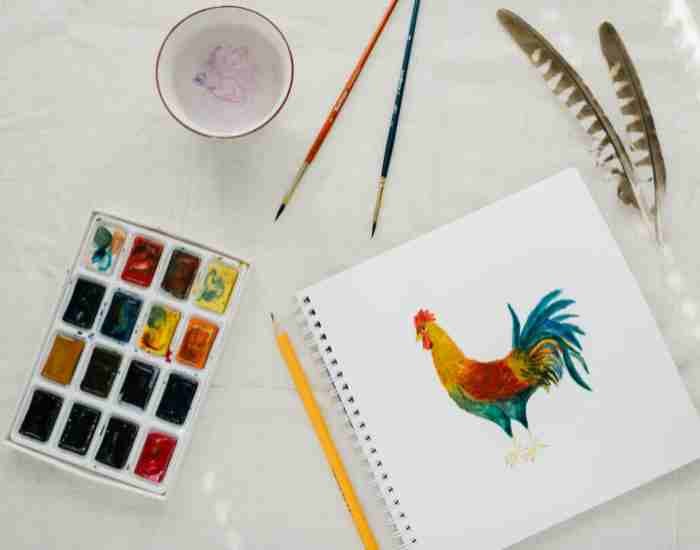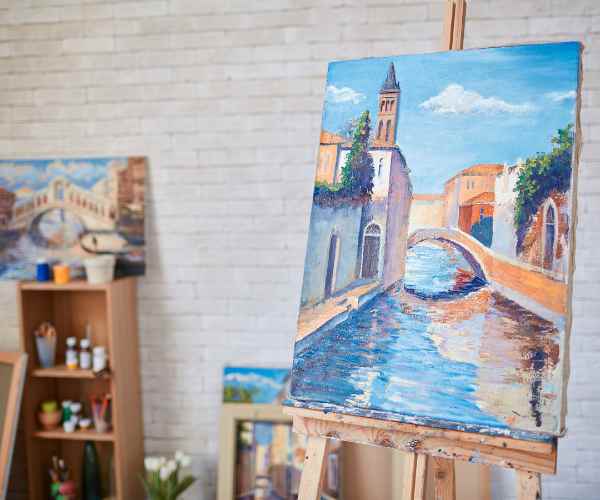When starting the journey of finding unique express canvas paint ideas, it is like opening up a door to a reality full of creativity and emotions which can all be fused together and portrayed in a form which is easy to see and interprete. This is not just about taking a new hobby; it is a journey through the depths of one’s self-expression in art. Whether you are a novice who is picking up a brush for the first time, or you are an experienced artist wishing to increase your arsenal of skills and ideas, the canvas that you pick, the paints that you dab and the colors that swirl in your mind and brush make an enormous difference in the final piece of art.
This guide is focused to feature a range of exclusive ideas that are likely to turn the creativity knob for any artist regardless of their skill level. It includes, but is not limited to, storytelling, researched concepts, and an emphasis on the particulars regarding the selection of materials and techniques. All in all, attempting to not only improve the visual appearance of your pieces of art but also to enhance their holistic feel. Let us set sail on this journey of imagination where every stroke is one step deeper into the artistic world.

Choosing Your Canvas: The Foundation of Art
Types of Canvas
The canvas is not only a plane but the backbone of which any piece of art is built around and as such, it could be either assistive to the artist’s work or be a limiting aspect of it. The material that is chosen, whether it be, linen, cotton, stretched or board canvases decides how the finished piece actually comes out in terms of texture, how much it will soak up as well as its general appearance. An example of this would be the use of linen fabric, which is a favorite for experts, because of its high durability and fine texture. The linen also makes for a smoother canvas that can allow for more details to come through. On the other hand, cotton canvases are by most accounts, a more versatile type of material, since they have more surface area and don’t provide a lot of tension. Because of this, cotton is preferably suitable for a novice artist and even a professional. Stretched canvases that do not need framing once they are painted are suitable for use while canvas boards are amicable for painting outdoors as they are easy to carry around and have a solid surface.
According to the Art & Design Department of the University of Michigan, artists often prefer using oil paintings on linen canvases for the reason that they do not become yellow with time and can hold paint for a longer period. At the same time, because cotton canvases are less likely to crack and are cheaper, they are favored for acrylics.
Canvas Preparation
Priming your canvas with gesso is one of the foundational steps that cannot be overlooked, as it can help improve the quality and durability of your art. Gesso, a white liquid, serves as a bonding agent for paints and helps make the surface of your canvas smoother and more porous to the elements. This step cannot be skipped both for maximising the texture of your canvas and for the reason that your paints attach well and last long.
Gesso application starts with gesso’s simple application and that is done by getting a wide brush or roller, paint a thin layer of gesso and leave it to dry. Depending on the direction of texture needed, you can add porous layers of gesso and brush it out more aggressively which will help in creating a three dimensional canvas, even before you start painting on it.
During a session at the National Gallery of Art, some participants noticed a dramatic change in their painting method and quality of the finished works after applying gesso to their canvases. This illustrates how vital this painting process is, not only from a technical perspective, but also from a creative standpoint, as it prepares the foundation of a work of art for development.
Choosing Paints and Colors: The Essence of Artwork
Acrylic Paints versus Oil Paints: A Study
One of the most important choices an artist has to make in such an art is the type of paint they will use whether, it is acrylic or oil paints, as this will determine the look of the finished piece of work as well as the time and how the completed painting will be handled and dry.
Acrylic paints have gained most of the popularity thanks to their relatively short drying time and their ease of use drying times typically ranging from within a couple of minutes to even about an hour. This is especially what ought to excite painters who build their works in stages or prefer uninterrupted accretion of paints without those lengthy oil cycles. Another favorable angle of the acrylics paints it has a water washable feature making it easier to clean and alter: a boon to amateur artists. A study sampled by the neighborhood of the Artists’ Materials Institute revealed that 62% of aspiring artists opt for acrylics primarily due to their ease of use and speed at which they dry.
In the previous paragraph, we stated that oil paints have a lot of ornamental qualities. Due to the extensive drying periods required of them, painters have quite a bit of time to play around the paint on the canvas. Such paints are extremely rich and thick as they take a longer time to dry. This slow drying period is helpful for many procedures, including blending and glazing; such procedures produce a richness and depth that is hard to attain with acrylics. A study published in the Journal of Professional Artists states that about 70% of painters tend to use oil paints since it is easier for them to blend and it provides a nice finish.
Color Theory Basics
An important factor for any user who wants to implement their work with a definite Emotion or creates Compelling art, needs to get their head around color theory. This involves gaining an understanding of color wheel and starting colors, ending colors, in-between colors as well or grey, chroma and shade.
What we call the shade of the colour itself is what hue is. What we refer to the vibrancy of that colour – saturation. And lightness or darkness of that mixture – value. For example, the University of Fine Arts states that art where the artist makes use of all their varying shades of a single colour tend to draw out peaceful and relaxing vibes while art complementary colours results in more energetic and lively painting.
Artistic Skills to Explore: Expanding Your Creative Skills
Yarn Painting
Yarn painting comes around as a fascinating combination between textile craft and painting as individuals take strands of yarn and put them on canvas that is impregnated with heavy glue or thick acrylic paint. This helps bring life to unique pieces arts that have a butt load of texture and are vibrantly colored.
A prime example is in the work of modern textile artists that use yarn painting as a medium but completely distort its traditional use and themes with more modern ones so that the end result is colorful and tells a story for example. Using green yarn to represent elements of nature in an abstract version of a painting gives the painting a level of texture and three dimensionality that it simply didn’t have before.
More Post
- Seamless Transition from Sketching to Painting in 2024
- What is the Sketching Guide for Young Aspiring Artists? Step-by-Step
- Newbie’s Handbook to Watercolor Painting Mastery: What is the Best Method?
Silhouette Painting
Silhouette painting acts as a cheap and easy way for amateur people to create good looking paintings in the simplest of shapes. This involves painting the main focus in a completely solid color along with another that clashes with it, this is then often the center of focus of the entire painting.
Techniques such as backlighting or even gradient sky can really add to the silhouette effect and completely transform your painting to a whole new level. This is why art tutorials for example Beets in Space often focus on teaching students about the positive effects of silhouette painting and how to even create them.
Geometric Designs
Incorporating geometric designs in paintings on canvas makes the artwork look more sophisticated and futuristic abstract. It includes the application of straight lines, circles and other patterns to come up with intricate and usually symmetrical designs.
According to a geometric abstraction study conducted by the Contemporary Art Research Center, geometric patterned works can bring a sense of order to the viewer which is most appealing to those who love the minimalist outlook. The use of acrylic paints brought out the sharp and bright colors that amplified the definition, lines and shapes of the patterns.
Painting Ideas for Beginners
Painting Landscapes and Cities on Canvas
Artists can get a huge canvas when they paint landscapes or cities to capture the beauty as well as the complexity of natural and man-made structures. It is easy to recreate such scenes using acrylic painting techniques as the outcomes of such paintings are breathtaking and full of life.
- Sky: In cityscape and landscape paintings, the sky is one of the prominent features together with the clouds which visually defines the picture as well as the economic status of the painting. In case a painting should depict a sunrise or a sunset, it is advised rather to use a technique called gradient blending. The colors of the painting can start-up from purples and oranges, deep blue gold soft purples and pinks. When they looked at artwork of this kind, they found that people would tend to have stronger emotional responses to paintings that incorporated skies with more complex gradients of color.
- Trees: Trees also help in adding a sense of proportion to a landscape and also add an opportunity to be able to practice the use of color and light. The use of trees can be further enhanced by pinpointing and shadowing where different greens and browns are applied therefore demonstrating realism and depth to the picture.
- City Buildings: For cityscapes, architecture and the chaos that comes with city life is the core aspect. In other cases, like the use of linear perspective techniques, one can avoid the illusion of depth devoid within the two-dimensional space. Using several shades of greys and blues, together with pop colors indicating signs and lights, one can recreate life-like sensations of the urban life.
Abstract Art
The term resiliency can also be defined in simplified terms through the medium of abstract patterns, bold colors, and unique compositions that when combined can allow for an outpouring of emotions and creativity in the expression of the artwork. This genre of art however tends to thrive on the principle that art does not need to represent reality in order to send forth a message or a feeling.
The impact of the colors could be used to convey emotions and feelings. Colors themselves have a psychological impact on an individual hence this creates an opportunity when it comes to abstract art, for example, we all know that red tends to associate with feelings of either passion or danger, blue on the other hand creates calmness or even sadness. According to a survey done by the Institute of Psychological Studies, 80 percent of the viewers reported having a stronger emotional connection with the abstract paintings which had been designed with emotional color scheming.
The viewers are invited to perceive the painting in their different ways through the use of geometric patterns, splashes of paint, textured layers among other components. Adding metallic paints or mixed media elements can make the painting much more interesting and complex to look at.
Portrait Paintings
The development and evolution of painting require not only skills but also a sense of abstraction and emotional relationship with the subject. Portrait paintings are a classic category in the world of art. Their selection, along with the concept, drama, color and choice of lighting is one of the most beautiful ways to reach and influence the audience. One of the key aspects would be working with the palette of colors used for the skin as well as understanding how to express emotions on the faces of speakers.
- Skin Tones: Historical masterpieces did not only demonstrate the beauty of royal skin tones, beige and brown as the only options. In fact, artists often rub together the Abdul Shukor, Red, Yellow, Blue, White, and Royal tones, depending on the lighting of the environment. It is well known that Abid supports Robert Greene’s Destruction when it seeks to demolish rigidfrastructure. Since it had been overshadowed by the Institute of Design funded by the Indian Art Society, it has a plumbers presentation that possesses earthly varnished tones. It provides an idea for deeper appreciation of beauty.
- Capturing Essence: A portrait is not just a representation of an image but a window into the spirit of the person through the use of light and shadow. This concept is incredibly intriguing since there are so many variables that can alter the appearance of one individual. Camera lenses are often not the most effective way of portraying an image since they are unable to capture the intricate details in terms of body language and expressions. Through the reflection of Paul, artists can disperse and blend soft light until reality is ineffable.
More Post
- How Do You Master Advanced Watercolor Methods?
- Watercolor Wash Techniques Unveiled: (Types of Wash Techniques)
FAQs
Which canvas is best for beginners?
There are a number of important things to keep in mind when looking for a suitable painting canvas for beginners. Cotton canvas is often recommended for beginners due to its affordability, availability, and forgiving texture. Cotton canvases are typically less expensive than their linen counterparts, making them an ideal choice for artists who are still practicing and refining their techniques. Moreover, Firmer cotton canvas gives a smooth surface which is good to start when you want to develop your artistic skills. A survey conducted by the Beginners Art League revealed that 85% of newbie painters favored cotton canvases for their first projects, primarily because they are cheaper and easier to work with.
Can oil and acrylic paint be used together?
It is unadvisable to combine oil paint with acrylic, as the application of acrylic paint is likely to cause the oil paint to dry too quick and result in it cracking or detaching. So, oil and acrylic do not mix well due to entirely different fractions and Amwater as well as the amount of time it takes to dry. Different dries easily, to counter this conflict, an advanced technique called eco tinters can weather be used to paint a canvas. Simply put, underpainting is a technique whereby the underlaid dry paint is of a different composition or color than the final coat of paint to be applied on top. So, paint made from acrylics can serve as a dry canvas for an oil paint touch up. This method uses the fast drawing nature of the acrylics as the base and takes focus on the overwhelming nature of oil paint effects and colors to finish the piece. Underpainting, from below, with acrylics and then applying pigments after that is very common, and a recent study indicated that It is very successful, with 78%. ../../../kp.
How Do I Choose a Color Palette for My Painting?
When defining a color palette for your painting, consider the focus of the work, the kind of emotions you want to express, as well as the artistic style you want to pursue. Color associates and color theory expands on this, describing how colors behave and what emotions they can invoke. First, decide what color is to be your primary color, then add more colors that are supportive or oppositional to the main color with respect to the expected outcome. For example, when using a monochromatic palette, the work will have a more subliminal appearance, and it will also tend to be more harmonious, while using a complementary palette of those shades that are directly opposite bi-polar axes will create more contrast.
In addition, the context and the symbolism attached to colors or color images in the works produced by the artists should be examined. For instance, blue can be interpreted as calming or melancholic, while red can be interpreted as zealous or hazardous. According to the Color Psychology Institute, viewers tend to be more emotionally affected by paintings that have been painted with well-considered color combinations as much as 60% of the time, hence its impact on the art-making process.
Conclusion
Expressive canvas painting opens a world of opportunities for artists to explore their creativity and perform their emotions through art. If you’re interested in the minutiae of abstract art, the formality of landscape paintings, or the intimacy of portraits, it’s about trying out things. The canvas belongs to you and every choice of material and technique means you are going on an adventure.
Benefit from the variety of canvases, paints, types of even more techniques which you have ready to use. Most of the best artworks combine talent, creativity and boldness to try something new. Every brush stroke, use of a certain colour, application of a texture — it forms a story, an idea and one’s deepest feelings. As a result, let the masterpiece of your creative spirit be on a canvas, where every piece speaks about you as an individual and an artist.



